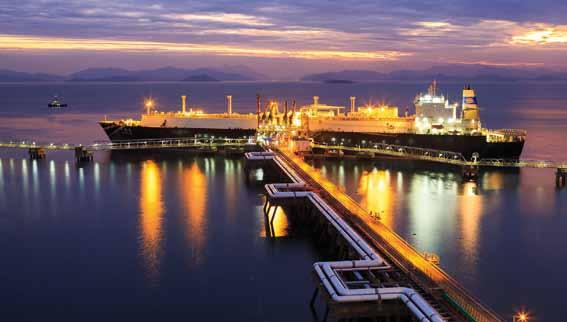
8 minute read
Reports from the Regional Coordinators
by IGU
Li Yalan
v Figure 1. In this issue we bring you updates from IGU’s Regional Coordinators for Asia and Asia-Pacific and for North America.
Overview of China’s natural gas industry
By Li Yalan Today, China is the world’s third largest gas market after the US and Russia and sixth largest gas producer after the US, Russia, Iran, Qatar and Canada. Last year, China surpassed the US to become the world’s third largest gas importer after Japan and Germany.
Market
Over the last decade, China’s natural gas market has experienced the fastest growth in the world.
From 2000 to 2016, China’s demand for natural gas has grown over seven times from 24.5 billion cubic metres per year (bcm/y) to 204 bcm/y, or 15% growth per year. Demand growth is expected to continue with gas seen
China’s growing gas demand
bcm 600
500
400
300
200
100
0
2000 2016 2020
Gas demand (bcm) Percentage in energy mix 2030 0.14
0.12
0.1
0.08
0.06
0.04
0.02
0
as an important fuel to combat air pollution, reaching 300-360 bcm/y by 2020.
In 2016, gas accounted for 6.2% of China’s total energy mix, up from 3% in 2000. The share of natural gas in the total energy mix is expected to rise to 10% by 2020 and 12% by 2030.
City gas accounts for 41% of total gas demand in 2016, followed by industry (28.9%), gas power (17.4%) and petrochemicals (12.8%). With an accelerated urbanisation pattern, city gas (including gas use for transport) will continue to be the main driver for gas demand. In 2016, city gas demand grew by 15% year-onyear. Gas power is another key driver, with demand in 2016 rising by 8%.
Supply
China has vast gas reserves with 50 trillion cubic metres (tcm)of recoverable conventional gas, 22 tcm of recoverable shale gas, and 12.5 tcm of recoverable coal-bed methane.
In 2016, China’s domestic gas production was 146 bcm, including 132.4 bcm of conventional gas, 1.6 bcm coal-to-gas, 5 bcm coalbed methane and 7 bcm shale gas.
In the same year, China imported 38.6 bcm of gas via pipeline from Kazakhstan, Turkmenistan, Uzbekistan and Myanmar, and 34.7 bcm of LNG from 13 countries including Qatar, Australia, Indonesia, Malaysia, Russia, and Nigeria. Imports accounted for 35.3% of total Chinese gas supply.
Infrastructure
China has developed an important domestic high-pressure gas pipeline network, with a total length of 70,000km in 2016. China is also
connected by pipelines with Central Asia (Kazakhstan, Uzbekistan and Turkmenistan) through three operating long-distance pipelines and a fourth line under construction. Together these pipelines have a total capacity of 85 bcm/y.
The Myanmar-China gas pipeline was completed in 2013, with a total capacity of 12 bcm/y.
Additionally, China has set up 12 LNG receiving terminals with a total capacity of 46.8 Mtpa, and 18 underground gas storages of 6 bcm total capacity, as well as 6,500 CNG/ LNG filling stations. A map of China’s major gas infrastructure is reproduced on page 64.
Policy
China is committed to making natural gas a major fuel in the energy mix, to both combat air pollution and reduce CO 2 emissions as part of the Paris Agreement.
‘The 13th Five-Year Plan for Energy Development’ has set the target of increasing the share of natural gas in the energy mix from 6.2% today to 10% by 2020, largely through replacing coal in various energy applications.
A large number of policies and measures have been put forward to both encourage upstream
gas production (including unconventional gas) and downstream gas development, through ‘the 13th Five-Year Plan for Natural Gas Development’, the “Air Pollution Prevention and Control Action Plan”, the “Energy Development Strategy Action Plan (2014-2020)” and ‘Policies for the Promotion of Natural Gas Utilisation’.
Third-party access to gas infrastructure has also been promoted by the government as a way to encourage gas supply and imports.
Challenges
Further gas market development in China is facing significant challenges.
First, gas needs to be more cost competitive to promote its utilisation, particularly as the country has cheap and abundant coal resources. The broad policies in favour of gas development need to be translated into concrete fiscal and financial incentives for using natural gas instead of coal.
Second, third-party access to gas infrastructure is crucial for gas market development. This is to be balanced against the need to encourage gas infrastructure investment.
Third, there needs to be detailed supportive policies for non-state entities to
c An LNG delivery at
Dapeng LNG in Guangdong province, one of China’s 12 regasification terminals.
Timothy M Egan.
v The Durango combined
cycle power plant in northwest Mexico. The importance of gas imports from the US and investment opportunities in the country should help to smooth current tensions.
participate in domestic gas exploration and production.
Last but not least, further development of the natural gas industry in China requires support not only from policymakers in the energy field, but also policymakers from all other sectors of the economy. This is why further advocacy beyond the energy industry is so critical for the future of natural gas development.
Li Yalan is IGU Regional Coordinator for Asia and Asia-Pacific and Chairperson of the Board of DIrectors, Beijing Gas Group Co Ltd.
North America
By Timothy M Egan President Trump’s victory in November 2016 and active agenda since his inauguration in January have been, and continue to be, the dominant topic of conversation in almost every field of policy in North America. Energy policy is no exception.
The expedited development of American energy resources, including all hydrocarbons, as a key means to deliver a growth strategy has been front and centre for Donald Trump since the earliest days of his candidacy. The appointment of Rex Tillerson to Secretary of State, Rick Perry to Secretary of Energy, Elaine Chao to Secretary of Transport and Scott Pruitt to EPA Administrator, all give powerful signals of how firm the President is on this agenda. What are the implications for the North American gas industry?
For the US, the President’s commitment to reduce regulatory burdens and corporate taxes, and to build out infrastructure, promise opportunity for gas resource development, transportation and distribution infrastructure expansion, and end use growth. Any federal discussion of the phasing out of hydrocarbons is off the table, and natural gas will benefit even more because of its affordability. After almost a decade of very difficult economic times, building on the strength of affordable gas to attract investment to the US creates a very positive picture. Whether state governments (and California stands out in particular) share that enthusiasm is questionable, and the strong protest movement against any infrastructure,

compounded by the post-election surge of anti-Trump protests, may pose local and state challenges to infrastructure construction. Trump’s impact on gas in the US? On balance things look good.
For Mexico, the US President’s strong language about the trading relationship and his commitment to “build the wall” have chilled almost two decades of warming relationships between the two countries. Some commentators think things will get much colder still, but, pun intended, gas warms things up: gas trade remains a good news story on both sides of the border. The US is a significant (and growing) exporter of gas to Mexico, delivering clean and affordable energy that helps the Mexican economy, improves the country’s environment, reduces balance of trade concerns and ultimately contributes to a rising standard of living. If there is a problem between the US and Mexico, gas should help to shrink the size of it. Moreover, US (and several Canadian) companies are very significant investors in gas infrastructure in Mexico, reinforcing an existing good integration story. Trump’s impact on gas in Mexico? If the bilateral political tension doesn’t undo things, the prospects remain very positive.
For Canada, the integration story on energy has long been a source of great strength for Canada and the US. The President’s rhetoric about Canada has been largely positive. He indicated in his first days in office his support for major pipeline interconnects, and his administration has made it very clear that the trading relationship with Canada (a bilateral free trade agreement existed before NAFTA) is the kind of relationship the US wants to have. All is not rosy on the Canadian side however. The development of unconventional gas resources across the US has meant Canada’s role as a key supplier is ending – potentially leaving (growing) Canadian gas supply stranded and looking for markets. In addition, the prospect of a significantly improved investment regime (see regulatory and tax changes noted

above) in the US, where supplies already have strong and growing access to international markets, will mean competition for Canada. And the great looming question is how markets will respond to the Canadian government’s promised “price on carbon”. As some commentators have noted, a Canadian “carbon tax” is the more likely border tax than any protectionist measure by the US Administration or Congress, as it will affect the competitiveness of Canadian energy exports and manufacturing. Trump’s impact on gas in Canada? Markets and Canada’s domestic policy framework will decide.
The long-term impact of Donald Trump’s presidency is one we will have to wait years to read about: in more than 140 character summaries. But it has certainly changed the status quo of North American energy policy. It could be very good for gas, depending in no small part on how policymakers respond to the new dynamic.
Timothy M Egan is IGU Regional Coordinator for North America and President and CEO of the Canadian Gas Association.
z While Canadian gas










